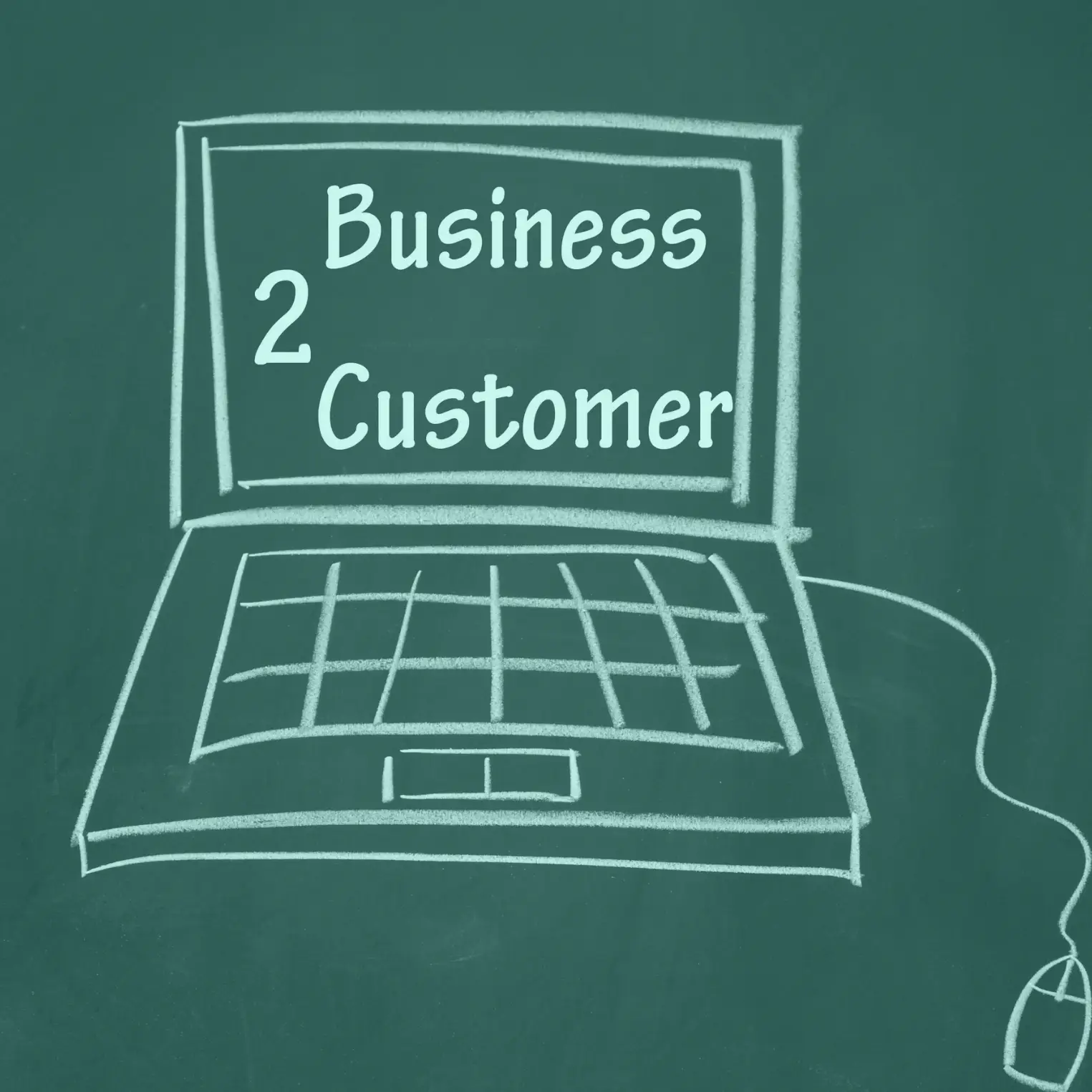B2C Email Marketing
Digital marketing can be of two strategies. Either B2B or B2C.
So, what’s the difference between B2B or B2C digital marketing?
On the surface, B2B digital marketing is done business to business, thus the name B2B. On the other hand, B2C digital marketing is done business to consumers.
However, as far as the sales process is concerned, the definition changes. B2B digital marketing focuses more on process-driven, logical, purchasing decisions, common in a business environment.
On the other hand, the B2C strategy emphasizes the emotion-driven purchasing decisions, common with consumers.
So, what is B2C email marketing?
B2C email marketing involves using the core sales process of a B2C email marketing campaign, through email as the primary channel. This might involve sending promotional emails, information emails, or newsletters to a target group of consumers.
In most cases, these consumers would have subscribed to the email marketing campaign.
An example is a simple welcome email that you might send once a consumer opens an account with your business. This email might brief them on what to expect as far as content and products are concerned.
So, how do you optimize B2C email marketing campaigns?
By using the right tools. These tools make it easier to not only send the marketing emails but also measure their performance and adjust correctly to better your conversion rate and ROI. And these tools are what you’ll be reading about in this piece. So, read on.
At the heart of HubSpot Marketing Hub is automation. This email marketing automation tool is based on the free HubSpot CRM. It carries great marketing automation tools for not just email but SMS as well.
One of the best features of the HubSpot Marketing Hub is personalized content, email, and outreach. This personalization is done based on your lead’s behavior, meaning you’re more likely to convert thanks to better-curated content, CTAs, and messages.
Pros
- Great onboarding support – HubSpot Marketing Hub is created to make onboarding easy. This means that your team will be able to get up to speed quickly, with customer support being available 24/7.
- Great support for integrations – HubSpot Marketing Hub supports over 500 third-party applications. This makes it easy to integrate with whatever tech stack you’re working on.
- Great reporting – HubSpot Marketing Hub provides highly detailed reporting that makes it easier to measure the performance of your email marketing campaigns and optimize for even better open rates, conversion rates, and ROI.
Cons
- They can get expensive – yes, HubSpot Marketing Hub provides a free-plan. However, this is for a very limited version of the entire product. As your list of requirements grows, their pricing can get very steep, which might not favor most small businesses.
Omnisend is becoming very popular within the eCommerce circles. Built specifically for eCommerce, Omnisend offers features that not only optimize your email marketing campaign but also SMS, WhatsApp, Google Ads, Messenger, Instagram, Facebook Ads, and push notifications.
Since it is built specifically for eCommerce, Omnisend features a flurry of templates designed to drive repeat buyers and reduce cart abandonment. These include virtual scratch cards, birthday discounts, and wheel of fortune offers.
Pros
- Great for eCommerce – Omnisend has a highly dedicated team that intimately understands the needs of an eCommerce business. This makes them one of the best choices for such businesses.
- Integration with top eCommerce platforms – Omnisend integrates with popular eCommerce platforms such as Magento, BigCommerce, and Shopify. It also integrates with helpdesk, review, and loyalty platforms such as Smile.io, Recharge, and Yotpo.
Cons
- Steep learning curve – Omnisend has a steep learning curve, compared to other B2C email marketing tools. This makes it hard to get up and running, making it not so ideal for large eCommerce businesses.
- High pricing – Omnisend is also not the cheapest email marketing tool. To access the features that make Omnisend stand out from the rest, you need a pro account that starts at $199 a month. This is for up to 10,000 contacts.
MailChimp is an industry leader in B2C marketing and automation. MailChimp allows you to deliver transactional emails and other personalized messages to your consumers while leveraging tools such as visual customer journeys to help curate the best experiences for your consumers.
This not only improves the overall customer experience but also drives conversion, turning leads, and prospects into paying customers.
Pros
- Great support – MailChimp comes with a flurry of resources including tutorials, guides, and case studies. On top of that, those on the free plan get 30 days of email support while paying users get unlimited chat and email support.
- Wide integration – MailChimp can be integrated with well over 200 third-party apps.
Cons
- Automation tools are not on the free plan – to fully optimize your B2C campaign, you’re better off buying the Essentials subscription or higher.
Just like Omnisend is curated for eCommerce businesses, ConvertKit is built for bloggers and online course instructors. This allows them to build their brands seamlessly, with more focus on content over marketing campaigns and deliverability.
And just like these two kinds of businesses demand, everything in CovertKit is plain and simple. The platform doesn’t even support email templates. Instead, it encourages plain text emails to increase engagement.
Pros
- Simple to set up – with no email templates to worry about, ConvertKit is among the fastest and easiest platforms to set up
- Great for building personal brands – ConvertKits best suits creators who are only interested in serving up regular content to their readers.
Cons
- Too basic – if you’re looking for a proper tool to optimize your email marketing, ConvertKit is not the best choice.
- Basic free plan – ConvertKit offers a free plan. However, you can’t send emails with this free plan, which locks you to the paid subscription.
AutoPilot is considered one of the better alternatives to HubSpot Marketing Hub. Just like HubSpot, this tool offers a visual automation workflow builder. However, AutoPilot comes with a twist.
It uses stickers, emojis, custom notes, and other details to make collaboration and the creation of marketing automation sequences fun for your team.
On top of that, AutoPilot is also easy to use and fairly intuitive.
Pros
- Great reporting features – AutoPilot offers great reporting on the performance of your email marketing campaigns, making it easier to measure success and adjust KPIs based on reports.
- Great onboarding support – AutoPilot offers unlimited support and emails with their subscriptions.
Cons
- There’s no built-in CRM – unlike HubSpot Marketing Hub, AutoPilot doesn’t come with an inbuilt CRM.
- No free plan – AutoPilot only offers a free trial after which subscriptions start at $49 a month, for only 2000 contacts.
If you’re looking for value for money, then MailerLite is one of the best options you can take. This email marketing tool offers a free package that allows you to send up to 12,000 emails per month, to a maximum of 1,000 contacts.
Another great thing about MailerLite is that it’s cross-industry. This makes it a very versatile tool that can adapt easily with your business as you pivot to serve changing market needs. This means that you can use it while starting as a side hustle, building up a freelance portfolio, or expanding to a bigger business.
Pros
- Beautiful email templates – MailerLite is great for sending beautiful emails for your blog or side hustle.
Cons
- No inbuilt CRM – if you are a small business with significant traffic, MailerLite may become too basic for your needs, since they lack advanced features that are supported by an inbuilt CRM.







